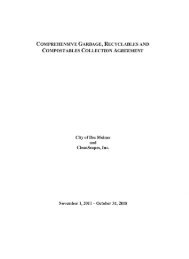CITY OF DES MOINES SHORELINE MASTER PROGRAM
CITY OF DES MOINES SHORELINE MASTER PROGRAM
CITY OF DES MOINES SHORELINE MASTER PROGRAM
Create successful ePaper yourself
Turn your PDF publications into a flip-book with our unique Google optimized e-Paper software.
Des Moines Shoreline Inventory and Characterization<br />
WATERSHED CHARACTERIZATION<br />
Ecosystem Wide Processes<br />
The City of Des Moines is located in the central portion of the Puget Lowland, a distinct<br />
geographic area, or ecoregion, based on topography, climate, land use, geology, soils, and<br />
naturally occurring vegetation. The Puget Lowland ecoregion is an elongate topographic and<br />
structural depression bordered by the Cascade Mountains on the east and the Olympic Mountains<br />
on the west. The distinct topography, geology, and soils of the Puget Lowland are the result of<br />
numerous glacial incursions into the Lowland from British Columbia during the Pleistocene<br />
Epoch (2 million years ago to about 10,000 years). This lowland is characterized by a series of<br />
ridges with the long axis trending in the north-south direction separate by deeply cut ravines and<br />
broad valleys. In general, the ground surface elevation is within 500 feet of sea level. The<br />
climate of the Puget Lowland is characterized by dry summers and mild, wet winters, with<br />
annual precipitation between 25 and >60 inches. Prior to the arrival of European populations,<br />
dense coniferous forests covered the Lowland. Vegetation in the Puget Lowland is dominated by<br />
Douglas-fir forests with western hemlock and redcedar as the primary late-successional species.<br />
Oregon white oak, Pacific madrone, big leaf maple, and red alder forests are frequent component<br />
of the landscape. In the southern Puget Sound region grassland habitats are often associates with<br />
oak habitats (WDNR, 2003). Other special habitats within the ecoregion include wetlands,<br />
riparian areas, bogs and estuaries. Characteristic wildlife includes a rich diversity of birds (200<br />
species), mammals and fish species. The City of Des Moines is characteristic of the ecoregion’s<br />
landscape, biota, and urban alteration. The City is located on the Puget Sound shoreline and<br />
contains characteristic areas of coniferous forest, and riparian and wetlands habitat, particularly<br />
associated with several small streams that flow from east to west through the City. The City is<br />
also characterized by substantial development and urbanization throughout the City’s<br />
boundaries.<br />
To understand shoreline processes and functions within the regulated shoreline jurisdiction, it is<br />
useful to understand the natural, ecosystem-wide processes that contribute to the conditions<br />
found along the shoreline and affect the natural, ecological functions occurring in the nearshore<br />
environment 2 . Alterations that affect the larger area may affect the natural shoreline processes.<br />
As water flow drives many ecological processes, a useful area for evaluation, smaller than the<br />
ecoregion, is the watershed. For purposes of this report, the Des Moines area watershed is<br />
defined as those stream basins that flow directly to Puget Sound and discharge in the shoreline<br />
jurisdiction of the City of Des Moines. These include Des Moines Creek, Massey Creek,<br />
McSorley Creek, Woodmont Creek, Redondo Creek, and Cold Creek drainage basins (Figure 3).<br />
Surface and groundwater flow in the watershed is naturally controlled by climate, topography,<br />
vegetation, soils, and geologic conditions, but is also altered by land use activities.<br />
2 The Puget Sound “nearshore” is generally considered to be an area that runs from the top of bluffs on the land across the beach<br />
to the point where light penetrates the Sound’s water.<br />
Page 8 March 2005



